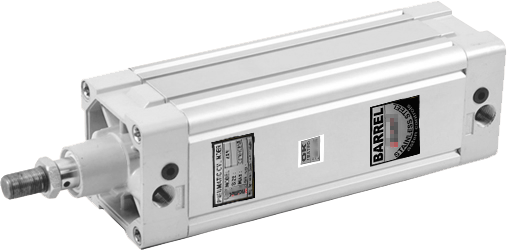
Pneumatic Cylinder : Save Energy and Improve Performance
Pneumatic cylinders are widely used in industrial automation due to their reliability, cost-effectiveness, and adaptability. However, inefficient use of pneumatic systems can lead to energy waste, increased costs, and reduced performance. This guide explores how to enhance the efficiency of pneumatic cylinders, reduce energy consumption, and improve overall system performance.
Understanding Pneumatic Cylinder Efficiency
Efficiency in pneumatic cylinders refers to the optimal use of compressed air to achieve maximum performance with minimal energy loss. Inefficient systems can result in leaks, pressure drops, and excess energy consumption, increasing operational costs and environmental impact.
In industrial settings, pneumatic systems often account for a significant portion of energy usage. Therefore, improving efficiency not only reduces costs but also contributes to a more sustainable and environmentally friendly operation. Companies that invest in optimizing their pneumatic systems can see substantial long-term returns.
Factors Affecting Pneumatic Cylinder Efficiency
- Air Leaks: One of the most common causes of inefficiency, air leaks can waste significant energy. Even small leaks can add up over time, leading to considerable financial losses.
- Improper Sizing: Using an oversized or undersized cylinder can result in energy losses and inadequate performance.
- Inadequate Lubrication: Poor lubrication increases friction, causing unnecessary energy consumption and increased wear and tear.
- Pressure Mismanagement: Operating at higher pressures than required wastes energy and may cause unnecessary strain on the equipment.
- Poor Maintenance: Regular inspections and servicing are essential to ensure optimal performance.
- Inconsistent Air Quality: Contaminants in compressed air can cause blockages and reduce the cylinder’s effectiveness.
Strategies to Improve Pneumatic Cylinder Efficiency
1. Optimize Air Pressure
Operate pneumatic cylinders at the minimum required pressure to reduce energy consumption without compromising performance. Over-pressurization is a common issue that leads to energy waste and mechanical stress.
2. Eliminate Air Leaks
Regularly inspect and repair leaks in hoses, fittings, and seals to prevent air loss. Advanced leak detection tools can help identify even the smallest leaks.
3. Choose the Right Cylinder Size
Select pneumatic cylinders that match your application requirements to prevent overuse of energy. Oversized cylinders consume more air than necessary, while undersized cylinders may not provide adequate force.
4. Use Energy-Efficient Components
Invest in cylinders with low-friction seals, efficient valve designs, and precision-engineered components. These technologies minimize energy loss during operation.
5. Implement Smart Control Systems
Utilize sensors and automated controls to monitor and adjust air pressure and cylinder operation in real-time. Smart pneumatic systems allow predictive maintenance and performance optimization.
6. Optimize Air Preparation Units
Ensure filters, regulators, and lubricators (FRLs) are properly maintained and adjusted. Clean, dry air improves the efficiency and longevity of pneumatic systems.
Technologies for Enhanced Efficiency
- Proportional Valves: Enable precise control of air pressure and flow, reducing unnecessary energy usage.
- Smart Pneumatic Systems: Use IoT and sensors for predictive maintenance, performance monitoring, and efficient operation.
- Energy Recovery Systems: Capture and reuse exhaust air for other processes, significantly reducing overall energy demand.
- Variable Speed Drives: Control the speed and stroke of cylinders efficiently, adapting to varying operational needs.
- Low-Friction Seals: Reduce internal resistance and enable smoother piston movement, lowering energy consumption.
Benefits of Improving Pneumatic Cylinder Efficiency
- Cost Savings: Reduced energy consumption translates to lower operational costs.
- Increased Productivity: Efficient systems ensure consistent performance and minimal downtime.
- Environmental Impact: Lower energy use reduces carbon emissions and environmental footprint.
- Longer Equipment Life: Reduced strain on components enhances durability and minimizes replacements.
- Enhanced Reliability: Efficient systems minimize unexpected failures, ensuring consistent output.
- Improved System Performance: Well-optimized cylinders perform tasks faster and more accurately.
Maintenance Tips for Long-Term Efficiency
- Regularly check for and seal air leaks to prevent pressure loss.
- Ensure proper lubrication of cylinder components to reduce friction and wear.
- Replace worn-out seals, gaskets, and other parts promptly.
- Monitor air pressure settings and avoid over-pressurization.
- Train staff on best practices for efficient operation and maintenance.
- Use automated monitoring systems for real-time diagnostics and alerts.
Future Trends in Pneumatic Cylinder Efficiency
The future of pneumatic efficiency lies in smart technologies, including real-time data analytics, predictive maintenance, and integration with Industry 4.0 systems. Advanced sensors and AI-driven systems will allow manufacturers to monitor cylinder performance, detect inefficiencies, and optimize processes automatically.
Additionally, sustainable manufacturing practices will drive the development of cylinders made from lightweight, energy-efficient materials. Innovations in sealing technology and air recovery systems will further reduce energy waste.
Conclusion
Improving pneumatic cylinder efficiency is essential for reducing energy costs, increasing productivity, and ensuring sustainable industrial operations. By adopting proper maintenance practices, utilizing smart technologies, and selecting the right components, industries can optimize their pneumatic systems for long-term performance and energy savings.
Investing in high-quality pneumatic cylinders from trusted suppliers ensures not only cost savings but also reliable performance and a reduced environmental footprint. Efficiency isn’t just an operational goal—it’s a long-term strategy for success.



